Songs are hits, today, because so many people hear them. Songs used to be hits because so many people played and sang them. But in those days, it took more than words and music to make a song a hit.
In the first half of the 20th century, every clubhouse, ballroom, social hall, tavern, hotel, and ocean liner rang with live music. Many homes had a phonograph or a radio or both; but the most important music machine was the piano in the parlor. And displayed on the stand above the keyboard were song sheets with colorful covers from Tin Pan Alley. Seeing them, someone was sure to pick one up and exclaim, “Oh! Let’s play this one!”
Some of Tin Pan Alley’s most creative people worked not on a piano but on an easel; they used pen and ink not for writing notes and lyrics, but for making art. The song was the steak, but the colorful cover of the sheet music was the sizzle that sold it.
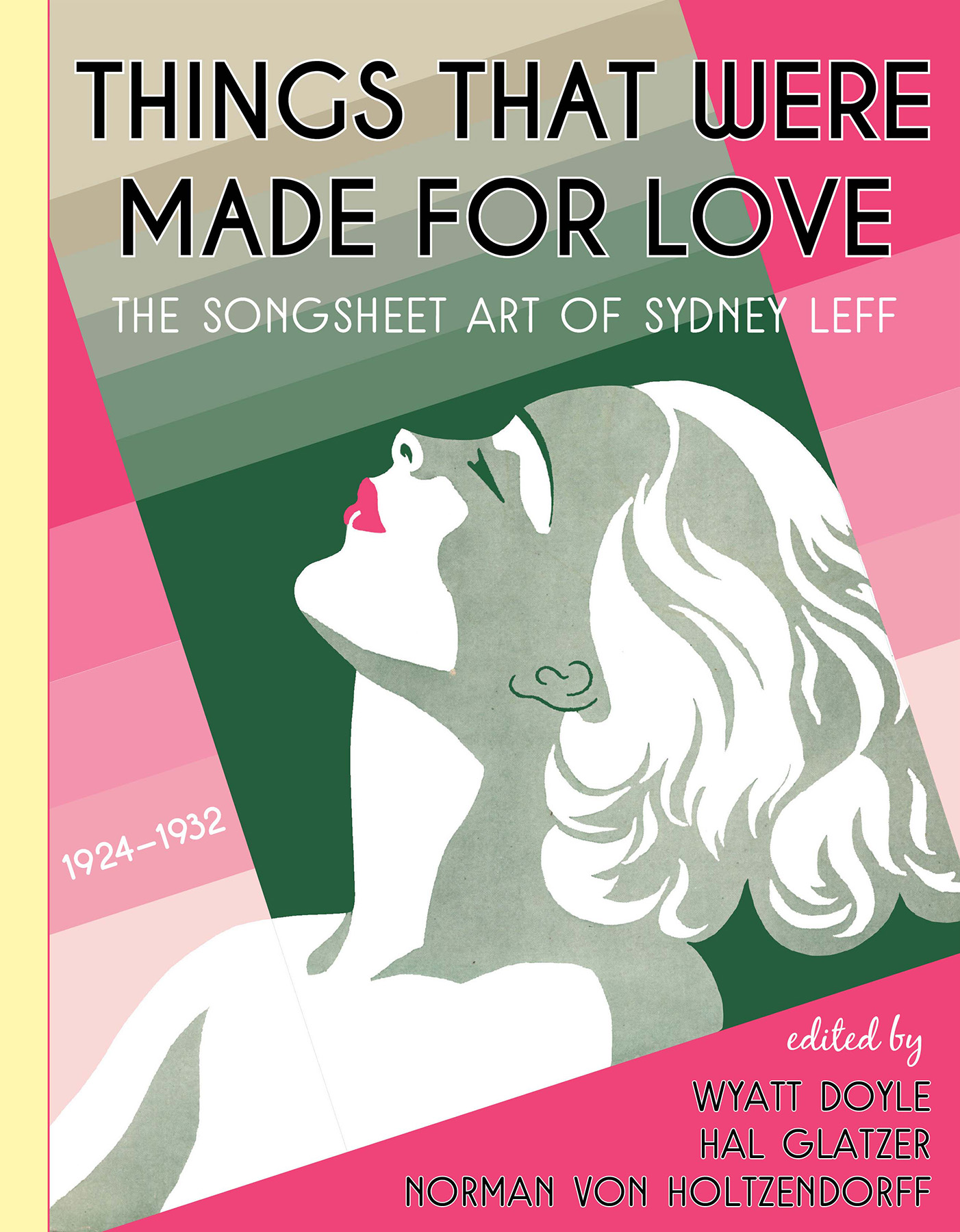
Once ubiquitous, songsheets are now primarily the province of dedicated collectors. But we—myself and my co-editors: collector-scholar Norman von Holtzendorff and writer Wyatt Doyle—are hoping to change that with our new, lavishly illustrated book, published by New Texture, that showcases the work of one of Tin Pan Alley’s most important cover artists. Things That Were Made For Love: The Songsheet Art of Sydney Leff 1924-1932 reproduces the cream of Leff’s songsheet covers from the earliest years of his career. It is our plan to continue the series, collecting later work by Leff as well as covers by his contemporaries. (Advance copies and special bundle packages are available via www.SongSheetArt.com.)
Who is Sydney Leff, and why does his artwork matter today? Why should his designs be celebrated now? Because songsheets continue to resonate, both with musicians who love to hear, play, and sing those songs, as well as with those who appreciate the elegant, playful, nostalgic designs and artwork of the all-but-forgotten commercial illustrators whose work adorns the covers.
Making Millions, at Five-for-a-Dollar
Sheet music was once a big business in America. Sales were the primary measure of a song’s success, and most composers earned more in royalties from printed, published music than from records. A turn-of-the-century printing process called offset lithography cut the cost of production, and retail prices dropped. Songsheets that had sold for fifty cents in the 1890s were five-for-a-dollar in the 1920s. And the most popular songs sold literally millions of copies.
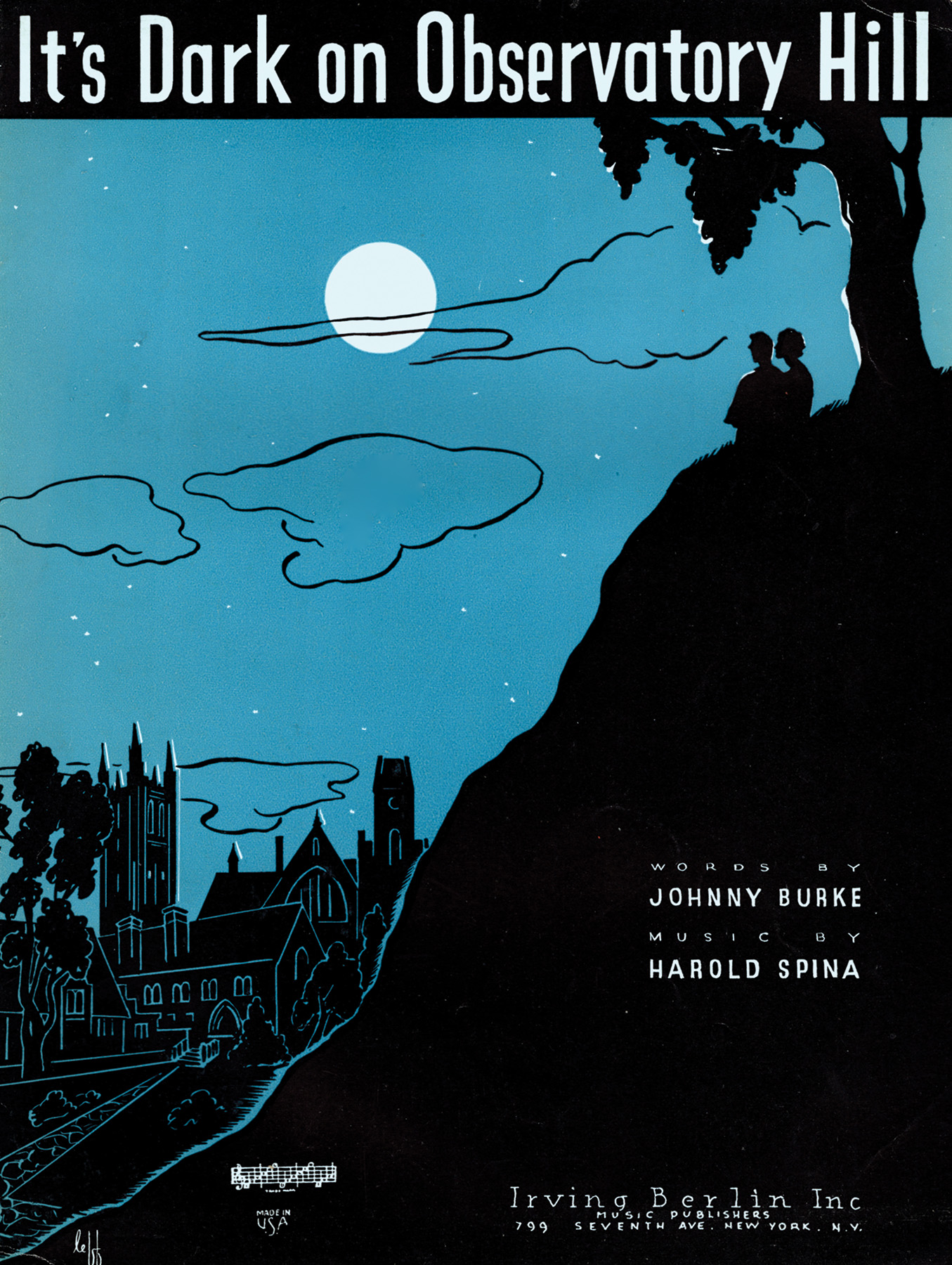
Music stores encouraged browsing and impulse buying. Department stores like Macy’s, retail chains like Woolworth’s five-and-ten-cent stores, and even the biggest drugstores all had music sections, their walls festooned with colorful songsheets. These were noisy places; one or two pianos—half a dozen, if the store were large enough—might be in use at the same time. Some were player pianos, driven by punched-paper rolls (which were also for sale). But most were non-mechanical uprights. And playing them were song pluggers—performers hired to make the new songs irresistible.
If you’d heard a song, or saw it performed on stage, you could ask for the sheet music. But if you hadn’t heard it, or couldn’t remember its name, or if a plugger didn’t happen to be playing it when you got to the store, there was still a way to make you want to buy it: the cover!
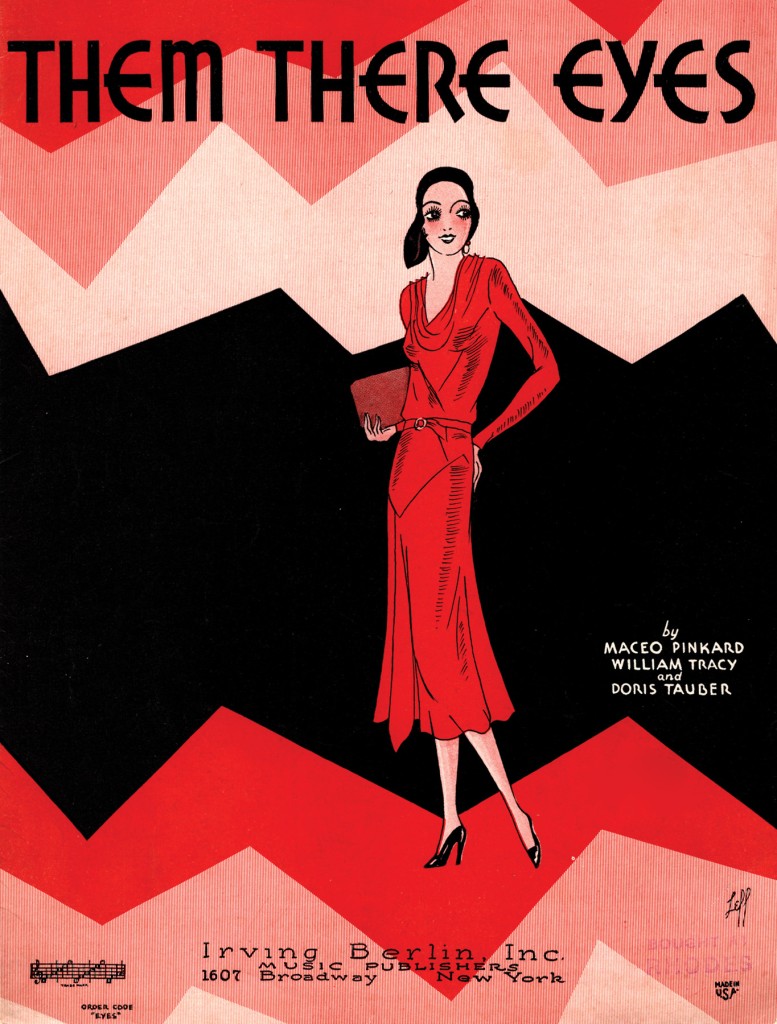
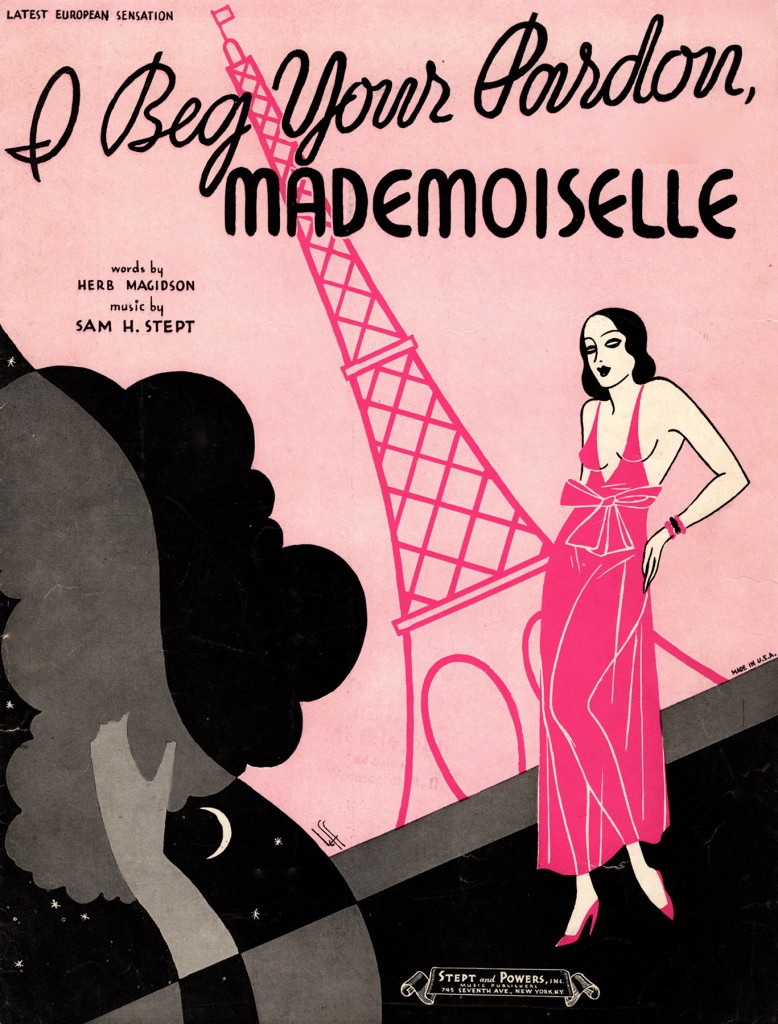
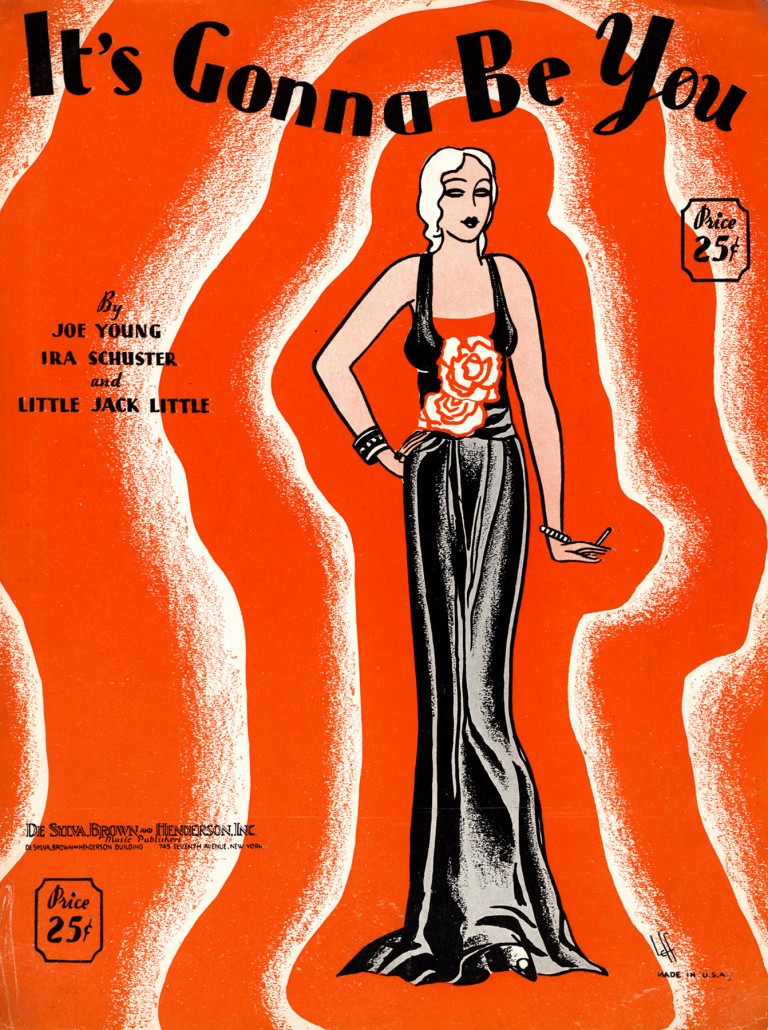
“Them There Eyes” (1930) marks a transitional moment between Leff’s depiction of flappers and the 1930s “Leff Ladies,” as seen here on covers for “I Beg Your Pardon, Mademoiselle” and “It’s Gonna Be You” (both 1932). (Illustrations from the Norman von Holtzendorff Collection)
Bold, multicolored graphics with refined hand-lettering attracted customers almost as powerfully as the songs themselves. Intriguing artwork caught your eye, stayed in your memory, and prompted your purchase.
Between 1900 and 1910 alone, one hundred different songs were reported to have sold more than a million copies each. Hundreds more reached that mark over the next two decades. In 1925, Musical Merchandise magazine reported that the average customer bought six to ten music sheets at a time, and a hit song could be expected to continue selling for at least nine months. Irving Berlin, renowned as a composer, was also probably the best-selling publisher ever; his “White Christmas” alone sold more than ten million copies.
Even small, regional publishers could do well. Joseph Flanner of Milwaukee boasted of having sold fifteen million copies of the rag “Pickles & Peppers.” Sherman, Clay & Co. of San Francisco, reported that from selling just nine songs (on 4,783,290 sheets), they grossed well over a million dollars.
But successes like that couldn’t and didn’t last. The Depression cut deeply into what people spent on entertainment. Small sheet-music stores could no longer compete with the big ones, and mail-order sales began outpacing retail. As early as 1930, a survey of music stores and instrument dealers blamed the decline in song sheet revenues on “fads and pastimes,” including the mechanical player piano, the automobile, and the card game of Bridge (“one of music’s most serious competitors for the public’s time and attention”).
But the phonograph—and especially the radio, which brought music into people’s homes for free—were the biggest competitors. In the 1930s, Billboard magazine tracked both “Sheet Music Leaders” and “Songs With Most Radio Plugs” every week; it is no coincidence that many songs made both lists simultaneously.
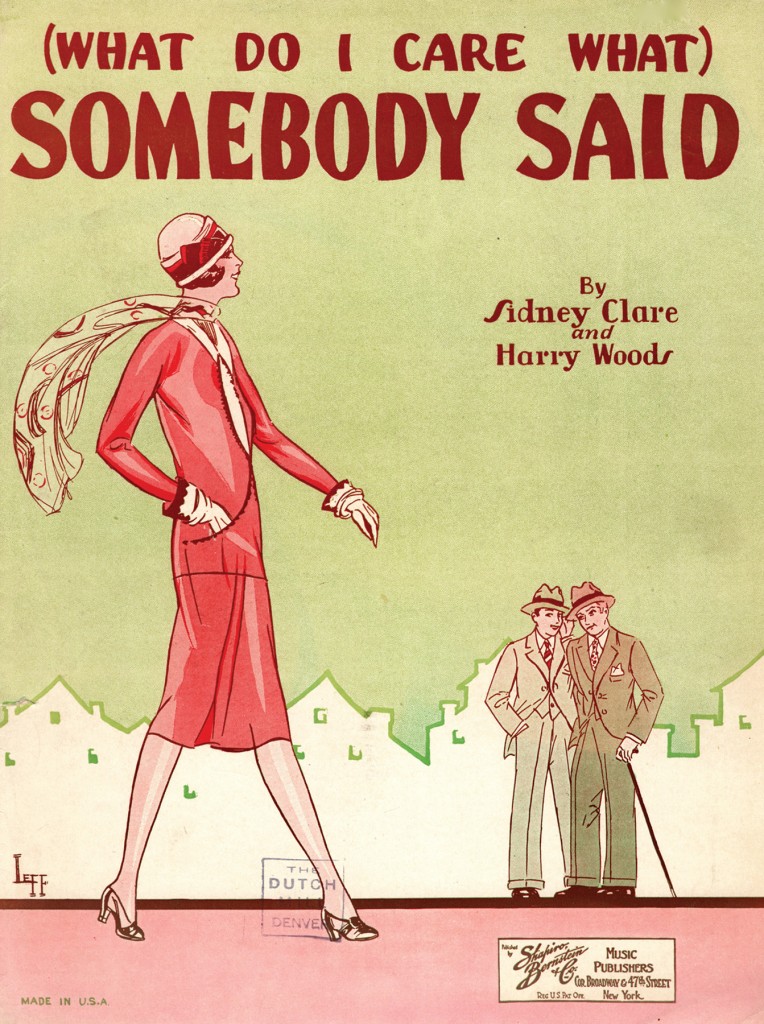
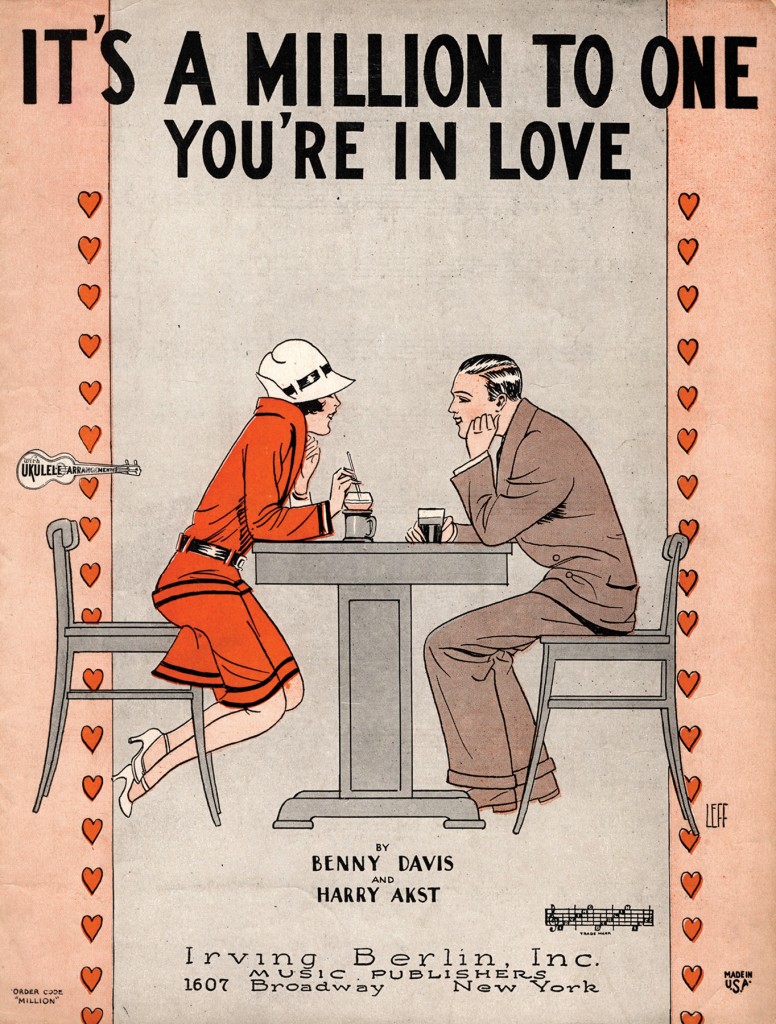
Two Sydney Leff “flapper” songsheet covers from 1927: “It’s a Million to One You’re in Love” and “(What Do I Care What) Somebody Said?” (Illustrations from the Norman von Holtzendorff Collection)
During the war years, it was especially difficult for people to spend evenings at home around a piano. Radios were a necessity for war news, and the soothing musical broadcasts that often followed helped to relieve anxiety. Radios and phonographs (unintentionally, perhaps) encouraged a whole generation of people to be passive listeners instead of musicians.
By mid-century, the sheet music business was moribund. Sales continued to fall off, profits dried up, and publishers were earning more from copyright royalties than from printing and publishing those songs. By then too, many publishers had been acquired by large entertainment corporations, mainly recording companies and Hollywood film studios, which had no experience or interest in selling paper goods; their bottom lines were better served by the sale of music in the form of licenses and recordings.
The Persistence of Ephemera
Music sheets were printed on slightly acidic paper, much like that of popular magazines. It was higher in quality than newspapers and pulp fiction, but lower than dust jackets and posters. Humidity and rough handling have hastened their deterioration, but many songsheets have survived. Collectors treasure them. And musicians, especially those who play vintage rags, jazz, and swing tunes, continue to discover new material (“OMG, there’s a verse!”) in old sheet music.
Some artists who later became famous, including James MacNeil Whistler and Winslow Homer, began their careers illustrating sheet music. For a World War I Liberty Bond drive, Norman Rockwell did a cover for George M. Cohan’s “Over There.” John Held, Jr. put his caricature flappers and sheiks on several sheets in the ’20s. And New Yorker cartoonist Peter Arno illustrated the programs and sheet music for shows he produced in the ’30s.
But practically all of the artists who designed sheet music covers for a living were, at best, minor figures in the art world of their time. The work of commercial graphic artists was not highly esteemed, and their original artworks for music sheets were never considered worth preserving.
Music covers did, however, draw upon and promote popular artistic trends: Art Nouveau after the turn of the century, and Art Deco between the wars. (Art Deco was coined in the 1970s, and encompasses both the sharp angularity characteristic of the ’20s, and the smooth streamlining that emerged in the ’30s.)
Layouts were standardized. The song’s title always went on the top. Often, but not necessarily, the composer’s and lyricist’s names appeared underneath the title, in smaller type. The illustration filled the rest of the cover, especially after advances in offset lithography enabled the artwork to “bleed” beyond the paper’s edge. A photograph of a singer or bandleader could be dropped into a cover if, in exchange, he or she would plug the song in performance –an early version of payola.
Paper sizes changed over time. Before World War I, sheet music measured 11″ by 14″. But a wartime paper shortage launched a trend toward smaller sheets: 6″ by 9″ for the duration, then 9″ by 12″ after the Armistice. And with that size to design for, cover artists—the unsung artists of Tin Pan Alley—really came into their own.
Meet Sydney Leff
One of the most prolific of sheet music designers was Sydney Leff, whom I interviewed in 1991. From an early age he wanted to be a commercial artist, and he became the go-to illustrator for many of New York’s biggest music publishers.
Born in Brooklyn on November 8, 1901, Leff grew up there. But he attended the Vocational School for Boys in Harlem, a long subway ride away, because it was the only high school in the city that offered a course in advertising art. (Broadway caricaturist Al Hirschfeld was in his class.) He later studied at the National Academy of Design, and at the Art Students League.
Leff got his first music cover commission just after high school, when he answered a classified ad in The New York Times, placed by songwriter Sam Coslow. The song’s publisher, Chas. K. Harris, liked Leff’s design and paid him $15 for it.
“That was a lot of money for a little kid who was starry-eyed,” Leff remembered. “But my fees went up after a year or so, to $25, and then to $35 for songs from Broadway shows. I got to know the composers by their first names, and they all knew me. When I walked down Broadway, I got big hellos. I was a kind of celebrity in the music business, too.”
Bandleader Cab Calloway once asked Leff to design a cover for one of his songs, with his (Calloway’s) wife posing for it. “I didn’t really approve of the idea, but I wanted to make him feel good,” said Leff. “So I designed the cover using a model who looked like her. He was happy.”
Leff and his wife Rita lived in Brooklyn, but he worked in Manhattan, taking the subway an hour each way to his own studio on West 43rd Street, near Broadway. “I used the hours on the train productively,” he said. “Sometimes I’d get two or three publishers’ assignments at a time. Irving Berlin’s company gave me a lot of work, but I also drew for the other major publishers, like Mills. I’d sketch or doodle on the train, and get ideas for upcoming work. I was very happy.”
Sheet music covers had lower status in the world of commercial art than posters, magazine covers, or dust jackets. And Leff had no illusions about his work. “Covers were a degraded form of art. It was like advertising art. I used to grind out covers by the dozen. They were not fine art. The fine arts people frowned on them, and the other commercial artists I knew looked at them that way too.”
Whether a song was a million-seller or a flop, the designer collected no royalties—only a flat fee. The artists had no clout with publishers, and they formed no professional society to lobby on their behalf. As Leff put it, “There weren’t enough of us in the business to make an association.
“But music covers spoke of the times,” he said, “probably more than the written word did. The period of the 1920s and ’30s was very colorful, very exciting. During the Depression people still played the piano, maybe more than they did before [i.e., in the ’20s], because it took their mind off money. I was making about $150 a week, and I was still naive enough, in the ’30s, to think that it was like that for everybody.”
There were hassles, though. “Publishers became very possessive about who they liked doing their covers. They resented it that I did covers for other publishers. They were very proud. Anybody trying to break in would have a difficult time. It was almost a political thing.
“But my contacts were mostly personal, like with Irving Berlin. I think I practically read his mind. I never had any difficulty having him approve some cover idea of mine. I’d read the lyrics and become inspired. After a while, it was second nature. I knew just what to do.
“There were formulas,” said Leff, “and artists followed them just like songwriters did. You know: moon, spoon, honeymoon; you put a palm tree in front of the moon, a starlit night…anything sentimental. I made it my business to be up on fashions, too, and I tried to make the women on my covers up to date. Sometimes I exaggerated a lot, but [fashion illustrator] Erté did too!”
After World War II, sales of records finally overtook sales of sheet music, and Leff saw the handwriting on the wall. He quit the music business and went into advertising, where he remained, except for designing the occasional book cover.
He stayed creative, continuing to design advertisements and brochures even after he’d retired to Florida in his nineties. His wife Rita died in 1979, but their daughters and granddaughters followed their example and became artists. Leff kept a collection of his own music sheets that is now in his family’s possession, and he was occasionally honored for his sheet music work by the local chapter of the Big Band Society in Florida.
Covers By Leff
There is no “typical” Leff cover.
On some covers he made the colors “bleed” to the edges. On others, he left a lot of open/negative space. He could draw cartoons. He could suggest the setting of a Broadway musical, or build a cover around the photograph of a celebrity performer. He could take chances.
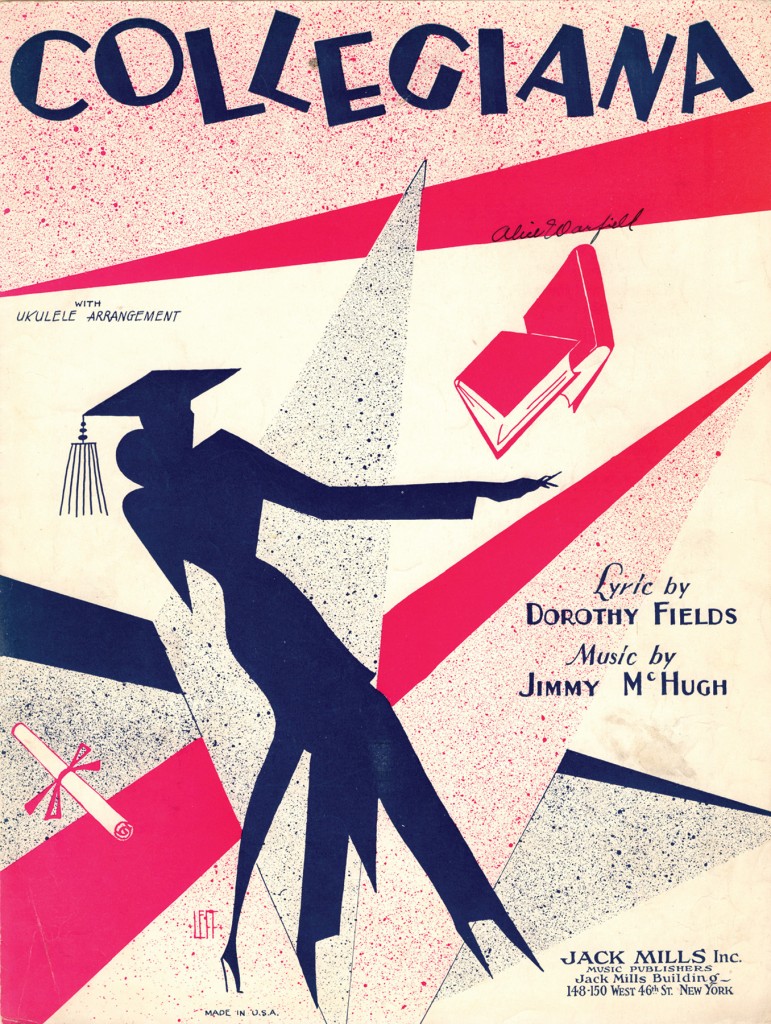
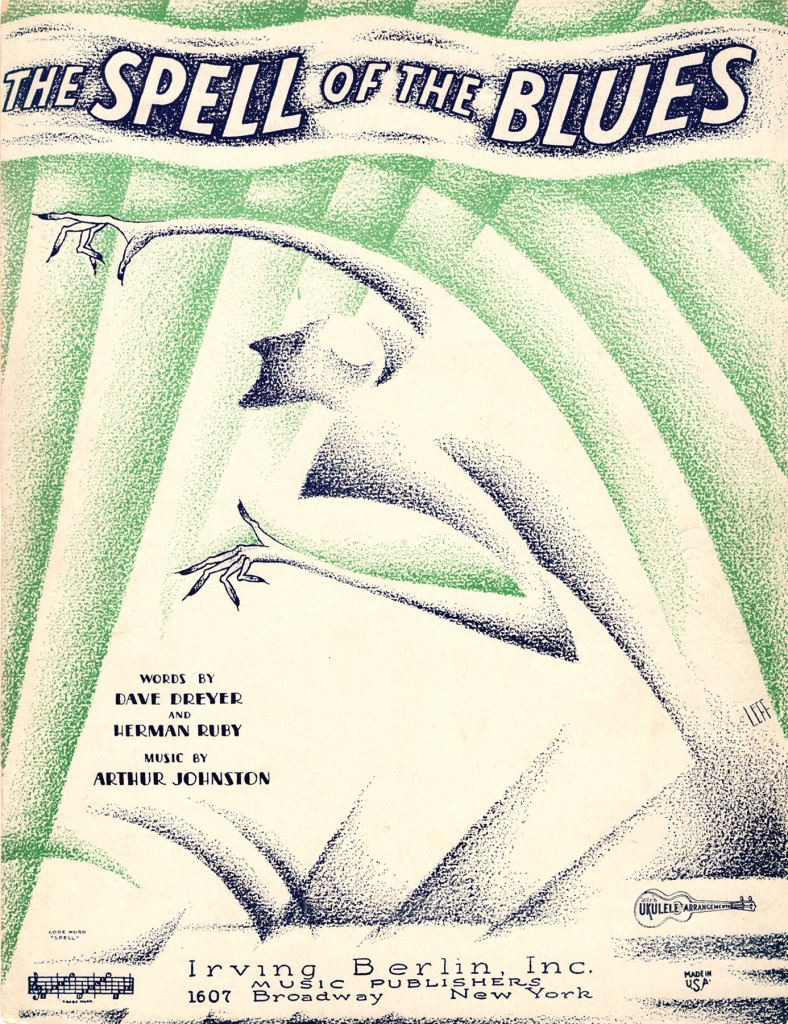
Covers of “Collegiana” and “The Spell of the Blues” (both 1928) featuring abstract, stylized imagery by Leff. (Illustrations from the Norman von Holtzendorff Collection)
Sometimes, when publishers preferred to call the shots, he would just have to settle for doing something banal but appealing. But the best of Leff’s covers have a refreshing spontaneity. Once he hit on a good idea, he let it develop naturally.
Leff prided himself on keeping up with women’s fashions. After the stock market crashed in 1929 and the Great Depression began, feminine couture changed dramatically. Designers turned away from the angular, boyish figure they’d championed in the ’20s, and embraced the curvaceous woman of the ’30s; and Leff’s covers illustrate that transition.
When he died at the age of 104, in December 2005, he had outlived all of his professional colleagues. And he thoroughly enjoyed being, as he put it, “the sole survivor of sheet music designers of that era.”
It seems only appropriate that the last man standing from the songsheet era be the first artist re-introduced to the public in our proposed series of songsheet art collections.
Find Things That Were Made For Love: The Songsheet Art of Sydney Leff 1924-1932 at www.songsheetart.com.
Hal Glatzer has numerous published works of fiction and non-fiction. Hal has been musical all his life and, while living in San Francisco, he became an officer of the Art Deco Society of California. Visit him online at halglatzer.com.






















